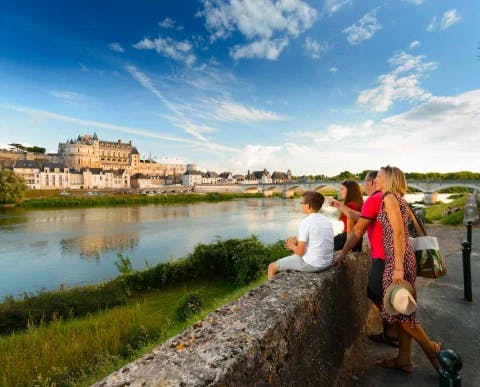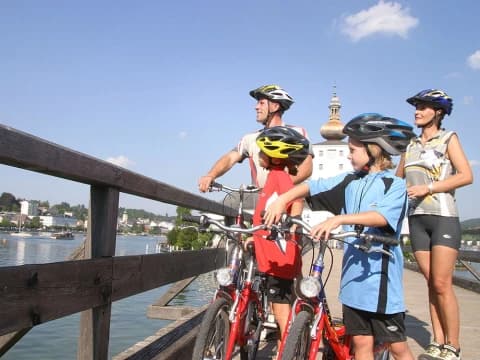This short guide provides useful tips for organizing a trip with snacks and food when travelling with children.
Travelling with children is a wonderful and memorable experience for the whole family, but especially when embarking on a cycling trip with children, it is important to plan the destination, route and type of accommodation, in order to choose activities and attractions that are suitable for the youngest ones.
In addition, it is essential to carry the necessary items to guarantee the safety of the children, such as clothing suitable for weather conditions, snacks and water, books and some games, medications and safety devices such as car seats and strollers, if necessary.
At the same time, it is important to pass on to children the pleasure of going and discovering, experiencing little adventures, smiling at inconveniences, setting off with confidence and curiosity.
Finally, it is always useful to mentally prepare and have patience: travelling with children can be challenging and unpredictable, but they are rich in moments of fun and discovery for the whole family.

Healthy snacks to bring on the trip: how to organize
Bringing along a small stock of healthy food from home not only saves money, but also avoids low quality foods often found along the route from home to the starting point of the tour, such as at the airport or on the highway, and limits the use of disposable plastic often present in snacks purchased on the go.
However, let's not forget to explore local specialty products during the trip or at the destination. The trip is a wonderful opportunity for children to discover the pleasure of trying new flavors.
When preparing snacks for the trip, it is important to ensure that they are simple to prepare and, especially when moving by bike, easy to carry. They also need to be suitable for consumption during the trip and with your hands, so easily manageable. Lastly, it is important to choose fresh and light ingredients, as food while travelling should always be light and easy to digest, even more so if you plan to do physical activity.
Travelling with children: which containers to use for food and drinks
To transport snacks on the journey without using disposable packaging, there are several sustainable options:
Steel lunch boxes: these are reusable food containers, durable and hygienic. They generally consist of one or more overlapping boxes, sealable by hinges or clips. Lunch boxes are available in different sizes and shapes, even with internal compartments, and are ideal for carrying home-cooked meals or snacks during the trip. Thanks to their stainless steel structure, they are easy to clean and last a long time.
The cotton snack bags are small reusable bags, made of 100% natural cotton, often organic. They are available in different sizes and colors and equipped with drawstring or zip fastenings. These bags are ideal for transporting sandwiches, fruit, snacks and drinks during the trip. Thanks to their cotton composition, they are washable and reusable.
Bee's wrap is a type of reusable and sustainable food film, used to preserve and cover food. It consists of an organic cotton fabric, coated with a mixture of beeswax, jojoba oil and pine resin, which gives it adhesive properties. Bee's wrap can be used to wrap fruit, vegetables, cheeses, bread and other fresh foods, creating a protective barrier that keeps them fresher for longer. In addition, thanks to the antimicrobial properties of beeswax, bee's wrap helps to prevent the formation of molds and bacteria. The bee's wrap is reusable and can be washed with cold water and neutral soap, and has an average lifespan of about a year. Once the bee's wrap has reached the end of its useful life, it can generally be composted as it is completely biodegradable and free of toxic substances.
Of course the water bottle! Usually made of stainless steel, aluminum, borosilicate glass or BPA-free plastic, the water bottle is the best solution to avoid disposable plastic bottles. Using a water bottle helps to reduce the consumption of plastic bottles, prevents the generation of unnecessary waste and pollution. In addition, water bottles are durable and long-lasting, they can be used for many years and are easy to clean. Carrying a water bottle means always having fresh and drinkable water available, avoiding having to buy water bottles when you are away from home.

What to feed children while travelling
If we want to bring some snacks from home, we can organize by doing a little shopping at the supermarket or the local bakery, trying to avoid foods that are too fatty or sugary and preferring fresh and natural products, rich in vitamins and fiber. Here is a list of ideas.
Crackers: better to choose those that don't crumble easily. To avoid single serves full of plastic we can choose a big pack and carry our crackers in small reusable containers. The rest can be left in the suitcase, which will go directly to the next hotel thanks to luggage transport.
Fresh fruit of the season. Better to remember to choose the most practical to carry and consume on the road: strawberries in spring, apricots in summer, clementines in winter, apples and pears in fall. The best solution is to wash and dry the fruit very well before leaving and, if necessary, slice it. We can add a few drops of lemon to the apple and pear slices to keep them from turning brown.
Dried fruit such as nuts, almonds, dates, dried figs, etc.
Veggies cut into sticks like carrots and celery.
Barrettes of cereals and dried fruits.
Small vegetable sandwiches for example with whole grain bread, hummus, lettuce, avocado.
Two slices of wholemeal bread with a square of dark chocolate
Apple chips and dried banana chips.
Water on the trip with children: how to organize
When travelling with children, it is important to organize to always have fresh and drinkable water available. The most practical and sustainable solution, especially when choosing an active type of holiday, is water bottles filled with water before leaving and then recharged in public fountains during the journey. Many public venues, such as bars and restaurants, offer the possibility of filling their own water bottle for free.
There are some apps to find drinking water fountains in a certain geographical area. These apps use geolocation to show the location of the nearest fountains, sometimes with additional information on the quality of the water and other services available.
They are very useful for those travelling or for those doing outdoor activities, such as cycling, hiking or camping, and want to always have fresh and safe water to drink.
Typically, these apps are free and available for Android and iOS smartphones, and are constantly updated thanks to the contribution of users who report new fountains or changes to information already present. An example is Water Fountains. It is user-generated and available for both iPhone and Android.
Finally, remember to regularly offer water to children during the trip, to maintain an adequate level of hydration and prevent any health problems.

Final recommendations
It is important to remember not to leave anything lying around when eating outside the home, to preserve nature and keep public places clean.
This means not leaving waste, such as food packages, plastic bottles, disposable cutlery or napkins, but collecting and throwing them into the appropriate waste sorting containers or carrying them with you until you find a trash bin.
Furthermore, it is important to respect the animals present in the places visited, avoiding damaging the surrounding environment or throwing waste in unauthorized places. In particular, even if children love feeding animals, it is important to inform and follow local indications on the possibility of sharing food with local animals.
With small responsible gestures we can contribute to preserving the environment and ensuring a more sustainable future for all.
Now that you know everything about dealing with a family trip, choose on Cyclando the route that suits you and your gang of little cyclists, and start an unforgettable, eco-friendly adventure.





